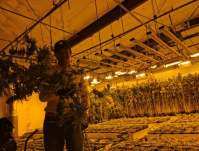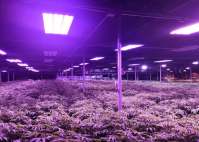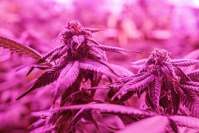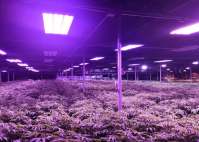The effect of LED grow lights on plant seedlings and the synthesis of nutrients
The performance of LED grow lights has been continuously improved, and the spectrum required for plant growth has been developed, which has also allowed LED grow lights to be widely used in various fields of agriculture.
The effect of LED grow lights on vegetable seedlings
LED grow lights can regulate the light morphology and growth of plants and have an important impact on vegetable seedlings. Photomorphogenesis means that plants rely on light to control cell differentiation, structure and function changes, including effects on the germination of some seeds, promotion of upward growth, inhibition of lateral bud growth, stem elongation, and tropism. Therefore, indoor planting with LED grow lights can better regulate the growth of vegetable seedlings, flower bud differentiation and flowering, and better growth conditions will bring earlier harvests and increased yields.
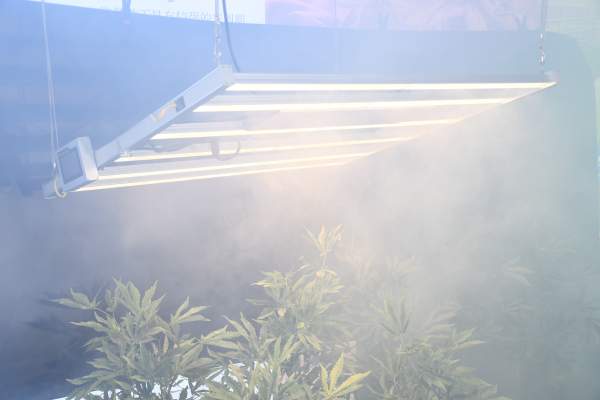
Generally, auxin is used to regulate the growth of vegetable seedlings, but vegetable consumption is detrimental to people's health. LED grow lights make the seedlings grow better through spectrum adjustment through unique light supplement advantages, green light promotes the elongation and growth of cucumber seedlings, red light and blue light inhibit seedlings from growing, and compared with monochromatic light quality, it contains red The index of strong seedlings increased under the compound light supplement light treatment of the blue component.
Red supplementing cucumber seedlings with LED grow lights can increase the chlorophyll a, chlorophyll b and carotenoid content of cucumber seedling leaves; LED grow lights with red light and blue light can significantly increase the leaf area, dry matter quality and seedling index of tomato seedlings, and supplement the red light of LED , Green light significantly increases the plant height and stem thickness of tomato seedlings. The red and blue combination of LED grow light can increase the stem thickness, leaf area, dry weight of the whole plant, root to shoot ratio, and seedling index of the eggplant. The red light energy of LED grow light can increase the stem thickness, leaf area, dry weight of the whole plant, and seedling index. Increase the biomass of the cabbage seedlings and promote the elongation of the cabbage seedlings. ED blue light promotes the thick growth, dry matter accumulation and strong seedling index of the cabbage seedlings. In this way, we know that the LED grow light regulation technology has a very obvious effect on the growth of vegetable seedlings.
The effect of LED grow lights on the nutritional quality of fruits and vegetables
The proteins, sugars, organic acids and vitamins contained in fruits and vegetables are nutrients that are beneficial to human health. LED grow lights affect VC synthesis and decomposing enzyme activity through light quality regulation to affect the content of VC in plants. The red light of LED grow lights promotes the accumulation of carbohydrates. The blue light treatment of LED grow lights is conducive to protein formation, and the combination of red and blue LED grow lights The effect of improving the nutritional quality of plants is significantly higher than that of monochromatic light.
The red light and red-blue combined light treatment of the LED grow light promotes the sugar and acid content in the tomato fruit. The use of the blue light supplement of the LED grow light can significantly increase the anthocyanin content of the egg skin, and the red light treatment of the LED grow light can Significantly increase the anthocyanin content of lettuce shoots, so the use of LED grow lights is very effective in regulating the nutritional quality of fruits and vegetables.
The effect of LED grow lights on plant growth
The way of artificially supplementing light with LED grow lights is not restricted by weather conditions. Plants perceive light signals by different photoreceptors, so LED grow lights can be used to control the growth of plants.
LED grow lights can affect vegetable growth, flower bud differentiation and fruit development, and ultimately affect its yield and quality. In order to regulate seedlings, there are three types of photoreceptors, phytochrome, cryptochrome and ultraviolet light receptors. Supplementing light at the corresponding stage of plant growth can improve the photosynthesis efficiency of plants, thereby promoting plant growth and development.
LED grow lights can increase the yield of plants. The number of cherries, total yield and single fruit weight of cherry tomatoes under the supplementary light of LED grow lights are significantly increased, which can significantly increase the single fruit quality and yield per unit area of squash and eggplant. Through the LED grow light quality and its intensity and duration of air conditioning, the plant growth cycle can be shortened, the commercial yield, nutritional quality and morphological value of agricultural products can be improved, and the feasibility of indoor planting can be realized.
Not only can the light quantity and light quality of LED grow lights be precisely adjusted according to the needs of plant growth, it also realizes the functions of energy saving, environmental protection and efficient use of space that cannot be replaced by traditional light sources. Based on these advantages, LED grow lights have been successfully used in various fields of indoor planting.


